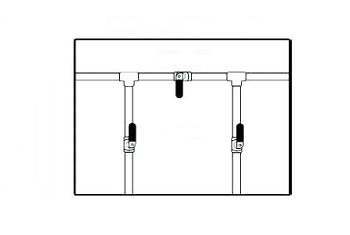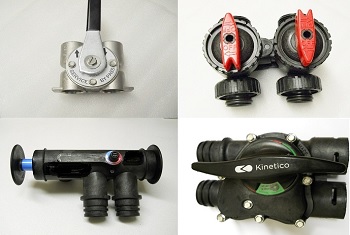Many people just assume that since they have a water softener installed in their home that all the water in their home is soft, but this is not always the case, and in some circumstances, it shouldn’t be. Do your outside faucets have soft water coming from them?
In most cases, a water softener will be installed at the point where the water enters the home. Installing a water softener directly to the main water supply to the home will ensure that all of the water in the home is softened as well as the outside faucets.
There are cases where a water softener is only installed to the water pipes that feed the inside of the home and sometimes only to the hot water for the home. Here we will discuss why all or only some of the water in a home is softened and how to know if your outside faucets have soft water coming from them.
Here’s What We Are Going To Cover:
- Do Outside Water Faucets Usually Have Softened Water?
- How Can I Tell If My Outside Faucets Are Connected To My Water Softener?
- Why Would I Want Softened Water From My Outside Faucets?
- Is Softened Water Harmful To My Lawn And Plants?
- How Do You Bypass A Water Softener From An Outside Faucet?
Do Outside Water Faucets Usually Have Softened Water?
Nowadays, most homes with hard water have a water softener that softens all of the water in the home including the outside faucets.
Most modern water softeners have become efficient enough to soften the water for outside faucets without using an excessive amount of water and salt.
In homes supplied by private wells with very hard water (more than 15 grains per gallon or so), it is not uncommon to have the outside faucets bypassed from softened water to conserve water and salt and to prevent the water softener from needing to regenerate often.
Also when lots of water is needed to water the lawn, plants, flowers, etc., bypassing the outside faucets from softened water will not only conserve water and salt, but hard water is often better for lawns, plants, and flowers than softened water.
How Can I Tell If My Outside Faucets Are Connected To My Water Softener?
Before you go and try to trace the plumbing in your home to see if there is a pipe going from your water softener to your outside faucets, the easiest way to know if the water from your outside water faucets is coming from your water softener is to simply test the water for hardness.
You can use an easy-to-use and inexpensive water hardness test kit to test the water coming from your outside faucets and know in a few seconds if the water coming from your outside faucets is soft or hard.
Check Out This Quick Video To See How Easy It Is To Check Your Water For Hardness
Why Would I Want Softened Water From My Outside Faucets?
It is commonly recommended that water for swimming pools should neither be very hard nor completely soft. (source)
Many pool owners will have softened water coming from their outside faucets to balance out the hardness of the water in their pool to prevent damage to the plumbing of their swimming pool but leave the water slightly hard to prevent surfaces from being too slippery.
Homeowners that wash their cars, boats, RV, or outside of their homes often would prefer to use softened water to prevent hard water spots on the surfaces that they are trying to clean.
Is Softened Water Harmful To My Lawn And Plants?
Many people think that softened water is harmful to grass and plants because it contains a high level of sodium compared to hard water. (source)
Actually, a properly working water softener leaves very little sodium behind after its regeneration process is complete.
Once the water softener resin has been regenerated, most of the sodium used by the water softener has been rinsed away, leaving only a minimal amount of sodium ions on the resin itself that it gradually removed from the resin as it removes hard ions from the water.
In some cases, dissolved iron which can be removed by a water softener could be in your non-softened water which could be more harmful to your lawn and plants than the small amount of sodium that would be in softened water.
How Do You Bypass A Water Softener From An Outside Faucet?
Run a separate water line to the outside faucet.
You can easily install a quick-connect “T” connector to the water line going to your water softener to supply your outside water faucets with un-softened water.
By diverting un-softened water to your outside faucets before it goes through your water softener, the water from your outside faucets will not go through the water softener resin inside of your water softener that would normally remove hard minerals and iron from your water.
Install a 3-way bypass to the outside faucet.

If you would like to have the option of having hard or soft water coming from your outside faucets, installing a 3-way bypass will allow you to change from soft water to hard water from your outside faucets simply by opening the bypass valve and closing the soft water valve.
You will need to install a quick-connect “T” connector to the water line before the water softener supplies the unsoftened water to the 3-way bypass, but this will give the ability to use both soft or unsoftened water from your outside faucets with just the turn of a few levers.
Bypass the water softener feeding water to the outside faucet.
Your water softener most likely has a bypass valve that allows you to divert your un-softened water from going through your water softener and instead it will send the un-softened water directly to the plumbing of your home.

The disadvantage of using your water softener bypass valve to provide un-softened water to your outside faucets is that you will also be providing un-softened water to the rest of your home.
If you choose to bypass your water softener when using your outside faucets, you may want to do it when no other water will be needed in your home to prevent hard water and iron spots on your water fixtures and be sure to put your water softener back into service mode when you are done using your outside faucets.
To Sum Up:
When a water softener is installed, it is usually installed so all of the water in the home will be softened including the outside faucets.
You can test the water from your outside faucets to see if the water is soft or not rather than trying to follow your plumbing to determine if the water from your outside faucets goes through your water softener.
You can request that a separate water line be run to your outside faucets to supply them with un-softened water but installing a 3-way bypass will allow you to choose to have soft or hard water from your outside faucets.




So, if I read this right. If I want to water outside with I softened water but I want soft water inside I need a by-pass. Does that mean I have to turn something off/ on whenever I am watering with well water. Our main well water line goes into our house in the crawl space . Would I have to go in there every time I watered the garden ??
Hello Robanne and thank you for the question.
If you want to use soft water outside and your outside faucets are already providing soft water from your water softener, you do not need to do anything. But if you want to use non-softened water from your outside faucets and they normally have softened water coming from them, you will need to bypass the water from going through your water softener.
This does not mean that you need to bypass the water at the earliest point that it comes into your home, you can install a bypass just before your water softener.
I hope this was helpful.
Paul